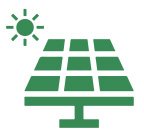Success Stories
RE-Powering Success Stories highlight the site redevelopment processes and accomplishments of completed renewable energy projects on current and formerly contaminated lands, landfills, and mine sites. Through these example projects, you can learn how developers, site owners, local governments, and other community members met challenges to convert underutilized lands back into productive use as solar, wind, or other renewable projects. The success stories also describe economic development and environmental benefits achieved by the projects and are organized by site type below.
Landfills
The most common RE-Powering projects are solar installations on landfills, with more than 300 projects completed across the country. Reasons for that success include typical landfill site sizes; municipal ownership; lack of shading; and access for existing electric grid infrastructure. Landfills are often an ideal size for community solar or remote net metered projects. The following are examples of renewable energy success stories at landfills:
- Sullivan’s Ledge Superfund Site, Utility-Scale Solar Energy Development, New Bedford, Massachusetts
- Scituate Landfill Solar, Scituate, Massachusetts
- Stafford Hill Landfill Solar Farm and Microgrid, Rutland, Vermont

- Brick Township Landfill Superfund Site Solar Redevelopment, Brick, New Jersey
- Fort Carson Landfill Solar, Colorado Springs, Colorado
- Nellis Air Force Base Solar, Frenchman and Yucca Flats, Nevada
Superfund Sites
Superfund sites are often attractive options for renewable energy projects because of the multiple ways that renewable energy can be utilized on-site or exported to the grid. Renewables can power a relatively small green remediation project to offset on-site cleanup energy demands and/or produce large amounts of power for wholesale use by electric utilities. The following are examples of renewable energy success stories at Superfund sites:
- Reuse and the Benefit to Community: Community Solar and Rooftop Solar at the Ventron/Velsicol Superfund Site, Carlstadt and Wood-Ridge, New Jersey
- Reuse and the Benefit to Community: Large Warehouse Rooftop Solar at the Welsbach & General Gas Mantle Superfund Site, Camden and Gloucester City, New Jersey
- Reuse and the Benefit to Community: Solar with Innovative Design, Reilly Tar & Chemical Site, Indianapolis, Indiana
- Apache Powder, Solar and Wind, Rio Cochise County, Arizona
- Pemaco Superfund, Solar Site Remediation, Maywood, California
- Lawrence Livermore National Laboratory Solar Site Remediation, Livermore, California
- Frontier Fertilizer Solar Site Remediation, Davis, California
- Green Remediation and Utility-Scale Solar Development: The Aerojet General Corporation Superfund Site, Sacramento County, California
Brownfields
Some Brownfield sites require little or no cleanup after undergoing an environmental assessment, allowing for rapid redevelopment into renewable projects. Other Brownfield sites require modest to more substantial cleanup before the sites can be returned to productive reuse and are worthwhile for renewable projects due to their unique characteristics such as locations near energy-consuming businesses, grid infrastructure, and communities seeking local redevelopment. The following success stories are drawn from the more than 100 completed Brownfields renewable energy projects in the U.S.:
- Thornton Heights Commons Roof Top Solar, South Portland, Maine
- Pownal Dam, Hydro, Pownal, Vermont
- Goodyear Industrial Campus Solar, Windsor, Vermont
- American Public University System Solar Rooftop and Parking Lot Array, Ranson and Charles Town, West Virginia
- The Reinvention of Martinsville VA, Battery Storage, Martinsville, Virginia

- Tech Town Geothermal, Dayton, Ohio
- Dreher Pickle Plant Solar Installation, Fort Collins, Colorado
- Belmar Mixed Use Development Solar Project, Lakewood, Colorado
- Housing and the Arts at Lamar Street Station Solar Installation, Lakewood, Colorado
Abandoned Mine Lands
As mining companies cease operations, communities are often left with vacant parcels of scarred lands. Many mine lands offer large parcels of open lands clear of obstructions to solar or wind development and can support renewable energy installations to return the lands back to productive use for the surrounding communities. The following are examples of renewable energy reuse at abandoned mine lands. The examples include Abandoned Mine Lands and Uranium Mill Tailings Radiation Control Act sites:
- Elizabeth Mine Superfund Site, Strafford, Vermont
- New Rifle Mill Solar Site, Rifle, Colorado
- Molycorp, Inc., Concentrated Solar Photovoltaic, Questa, New Mexico
Resource Conservation and Recovery Act Sites
Cleaned-up RCRA Corrective Action facilities can support redevelopment and community revitalization. By using the appropriate tools and remediation, RCRA facilities can achieve several purposes – contamination clean up, enhancing communities, and reducing greenhouse gas emissions. The following are examples of renewable energy reuse at RCRA facilities:
- Bethlehem Steel Winds, Lackawanna, New York
- Former Maytag Appliance Factory Green Manufacturing, Newton, Iowa
- Chevron Wind Installation, Casper, Wyoming
Waste Water Treatment Plants
Waste Water Treatment Plants often have both land that is suitable for renewable energy installations and can use the renewable power to reduce on-site energy bills. An example of a waste water treatment plant project reuse on a formerly contaminated pond is:
